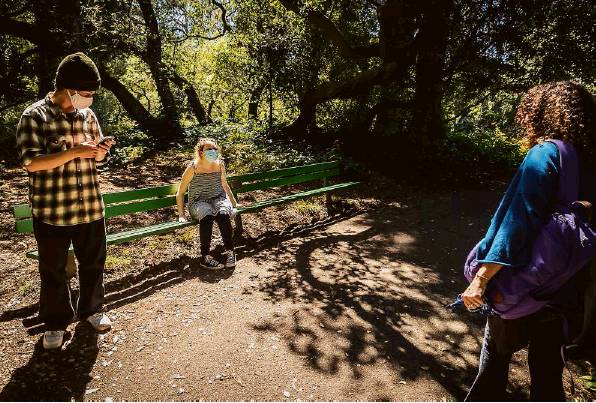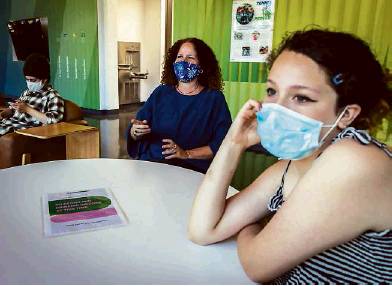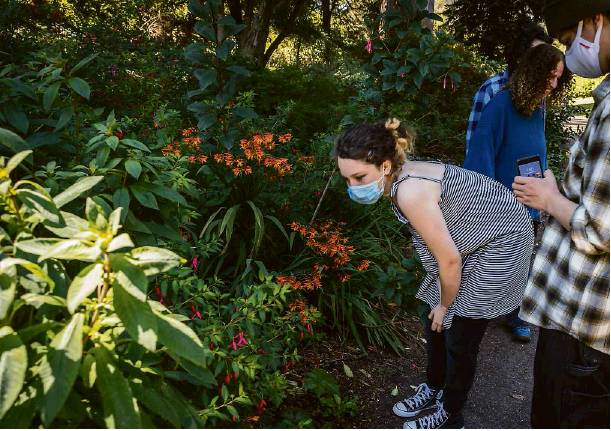How to keep kids safe in delta era
Experts dish latest advice on parenting tasks
By Aidin Vaziri
This is a scary time for parents.
Children are returning to school as the highly infectious delta variant is sending more younger people to hospitals nationally than at any other point in the pandemic.
While the situation in the Bay Area is not nearly as bad as in hot spots such as Florida or Arkansas, data from the California Public Health Department shows that new cases in children younger than 17 are now outpacing those in people 50 and older.
“I get tons of emails from parents every day,” said Marissa Glidden, president of the teachers union in Richmond. “They all want their children to be in school, but they want to know what they can do to keep them safe.”
On top of the routine challenges of getting kids out the door every morning, many families are worried about a new set of hurdles.
“I’ve gotten two or three letters now that my son has been in contact with COVID at his high school,” said Marjorie Sturm, a mother of two in San Francisco. “He’s vaccinated, and I’m not sure how to react to these letters. If I even have the energy to react.”
Here’s the latest advice from experts on protecting children, especially those younger than 12 who do not yet have access to coronavirus vaccines, during the delta surge.
What kind of masks should children be wearing in schools now?
“We are at a point we need to step up from cloth masks,” said Anne Liu, an infectious disease doctor at Stanford University and mother of two.
Experts say cloth masks do not provide enough protection against the delta variant, which is believed to be twice as infectious as the original strain of the coronavirus and transmissible even by people who are fully vaccinated. If your child is in a classroom all day, experts recommend a three-layer surgical mask at minimum.
But double masking may be preferable, even for children who are vaccinated.
“You want to model the kind of behavior you want your children to take.”
Michael Stanton, clinical health psychologist at California State University East Bay
“If I’m sitting in school, I would wear a surgical mask right on my face and a good two-layer cloth mask on top of it,” said Dr. Robert Wachter, chief of the department of medicine at UCSF.
The Centers for Disease Control and Prevention says it is critical that masks fit snugly against your child’s face, covering the nose, mouth and chin. Liu emphasizes that any well-fitting mask that a child can tolerate for a long time is better than nothing but agrees with the strategy — especially for older children — of layering “a cloth mask with a filter or surgical mask.”
Liu said her younger, unvaccinated son usually wears a KN95 mask, which is an alternative to an N95 respirator and widely available in children’s sizes, though it’s important to look for high-quality options.
“If everybody’s masked, then that massively lowers the probability of anybody getting infected,” Wachter said.
How should children navigate lunch and recess?
After sitting dark for more than a year, most Bay Area classrooms were configured to mitigate the spread of the virus with a host of new features, including ventilation systems, hand sanitizing stations and physical distancing markers.
“Schools have become like hospitals,” said Dr. Monica Gandhi, an infectious disease specialist with UCSF. “They are doing everything in their power to keep them safe.”
The risk of transmission rises between class periods when students are less supervised and more likely to let their guard down.
“Our teachers are doing such a good job making sure students are following protocols in the classroom,” Glidden said. “But once things get casual, like at recess, the students can get in each other’s faces, and the mask-wearing can get a little sloppy.”
Michael Stanton, a clinical health psychologist and professor of public health at California State University East Bay, said the best thing parents can do is lead by example.
“You want to model the kind of behavior you want your children to take,” he said. “Show your child how to fit their masks. Show them how to keep a little distance between people.”
Lunchtime can be especially fraught, as children must remove their masks to eat, typically near others.
“If the student has the option to eat outside, encourage your child to eat outside,” Glidden said.
Children should put the masks back on their faces as soon as they finish eating.
When should you keep your child home from school?
Some families decide to keep children home on days when sending them feels unsafe because of a case at school, even if the child is not in quarantine.
“We’re certainly going to see cases in the schools,” Wachter said. “But it’s very much colored by how much virus is there around in the community.”
To a child, being told to stay home might feel punitive, Stanton said.
“You want to emphasize the purpose of what you’re doing and why you’re doing it,” he said. “Let them know, ‘We are doing this for your safety and to make sure we don’t spread COVID.’ ”
But the No. 1 thing families should do, Glidden said, is “keep their students home when they’re sick. Even if you think it’s allergies, keep your kid home and get a COVID test.”
Families should use at-home rapid antigen tests to confirm whether their students have the coronavirus and are infectious while waiting on the results of a PCR test required to return to school; the over-the-counter tests aren’t as accurate with asymptomatic cases. That can help prevent spread to family members.
“Even if they’re not as reliable as a PCR test, the rapid tests are pretty good at detecting when someone is contagious,” Liu said. “Their strength is that they are super-fast and super-easy.”
The drawbacks of the over-the-counter rapid tests are they are currently hard to find in the Bay Area and range in cost from about $20 to $40, which can be prohibitive for some families.
“I don’t understand why our schools aren’t doing weekly testing like Los Angeles and other school districts are doing,” Sturm said. “It’s such an important mitigation strategy that is even paid for by the state. It makes no sense to me.”
How can kids stay safe outside of school?
“What happens outside the classroom has such an impact on what happens inside the classroom,” Glidden said.
That means parents will have to exercise caution outside of school. While routine disinfection of backpacks and shoes is not needed, children should safely remove their masks for cleaning and wash their hands with soap and water when they get home.
Families may also want to think carefully about high-risk activities such as sleepovers and carpools with other families if they are uncertain about their COVID safety.
“Limit the contacts. Prioritize the schools. Deprioritize the indoor playdates,” Liu said.
Parents may also want to limit indoor activities outside of school, and the adults in the family should make sure they are vaccinated and wear masks in public settings.
“We’re seeing transmission from parties, events, movie theaters,” Glidden said. “Remember, young children are unvaccinated. They’re still vulnerable.”
Stanton said being cautious does not mean living in isolation but being smart about how you socialize.
“Social contact is incredibly important to children, and we want to make sure there’s space for that in some way,” he said. “We should be replacing those indoor events with outdoor events, where we know it’s safer. When we look at the benefits of school, some of it is education. But most of it has to do with socialization. That’s why it’s important to prioritize it.”
There is no wrong way to do this.
Experts acknowledge that parents are in uncharted terrain with an unpredictable virus and a pandemic that has stretched much longer than anyone expected.
“As much as we’re trying to make this the safest we can, there’s no perfect way to do this,” Stanton said. “We have to be kind to ourselves. It seems very important that we remind ourselves that we’re doing the best we can.”
The delta variant has proved to be a hardier foe than many infectious disease specialists predicted, Wachter noted. Despite the generally cautious behavior of Bay Area residents and a slew of mitigation measures from regional health departments, it may be a while before we emerge from the current surge.
“Delta is so incredibly transmissible that unless we get back down to a very low level of cases, I still think it’s important that people be careful,” he said.
The most important thing parents can do is get vaccinated and ensure those around their children are as protected as possible against COVID-19 as well. Stanton said it also helps to stay motivated, look to the future and realize there is a point where we might get past this. And there will be stumbles along the way.
“Despite doing everything perfectly, there’s still a chance our children can catch COVID,” Stanton said. “That doesn’t mean we failed as parents. We have control over parts of it, but so much of it is random. We’re all doing the best we can.”
Aidin Vaziri is a San Francisco Chronicle staff writer. Email: avaziri@sfchronicle.com


